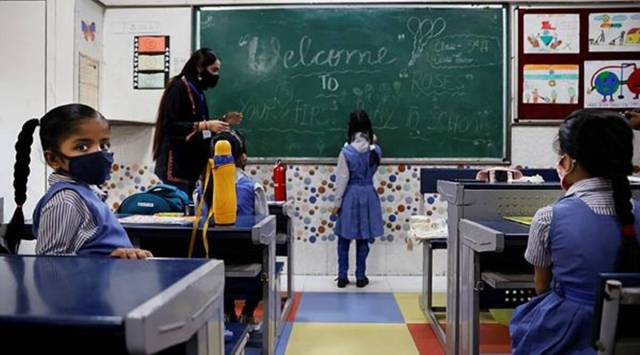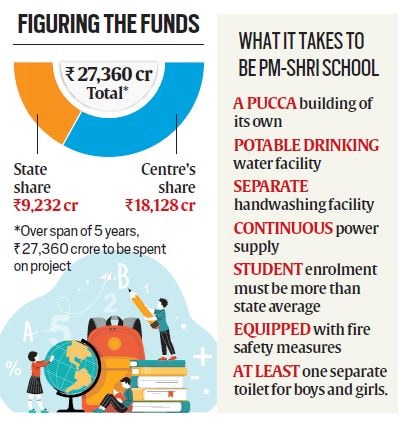Government schools which will be upgraded to PM-SHRI schools (PM Schools for Rising India) will be developed as ‘green schools’ and will teach children about the country’s heritage and instil the values of ‘Bharat’, the Union Ministry of Education has informed all states in a letter.
The schools will make students competent in Indian languages, and also work on “linking students to local industry for skill development”, the letter stated.

“The union ministry has further said that the online portal will open from October 1 to November 30, and during this period, the government schools in the state can apply to participate in the selection process for upgradation as PM-SHRI schools,” a senior official from Punjab education department said.
Under the scheme, Prime Minister Narendra Modi-led government aims to develop at least 14,500 existing government schools in the country.

The union cabinet approved the PM-SHRI scheme on September 7 and Rs 27,360 crore will be spent on it over a period of five years; the Centre’s share will be Rs 18,128 crore while the state share will be 9,232 crore – a 60:40 ratio.
Regarding the selection process, the letter states that schools will be selected for the PM-SHRI through a “challenge mode”, that is, schools will be required to apply on the portal which will be opened four times a year, once every quarter, during the first two years of the scheme. A maximum of two schools (one elementary and one senior secondary) will be selected per block/urban local body.
However, not all government schools will be eligible to participate in the challenge, as per the letter. First, the states have to sign a Memorandum of Understanding (MoU) with the union ministry ‘laying down the commitments to implement National Education Policy (NEP), 2020’. Then, the eligibility of schools will be identified by checking if they meet the requirements of certain Unified District Information System for Education (UDISE) data parameters.
Story continues below this ad
The letter clarifies that no predefined target has been set for the number of schools to be selected and that the results of the ‘challenge’ will determine how many schools are finally selected for the scheme.
“These schools will be learning spaces in which every student feels welcomed and cared for,” says the letter, adding that under the scheme elementary schools (class 1 to 8) and senior secondary (class 6 to 12) managed by state/centre will be considered.
Notably, the Aam Aadmi Party (AAP) government in Punjab has started the process of selecting 100 government schools which will be upgraded as “Schools of Eminence” along the lines of the ‘Delhi model of education’. School Education Minister Harjot Singh Bains has been visiting schools across the state and the state education department has been conducting a statewide survey to gather data on infrastructure, staff numbers and provision of basic amenities. in government schools of Punjab.

| Minimum requirements for a school to be selected |
| A pucca building of its own |
| Student enrolment must be more than state average |
| potable drinking water facility |
| separate handwashing facility |
| continuous power supply |
| Equipped with fire safety measures |
A focus on values of ‘Bharat’
Story continues below this ad
“Students will be rooted to the knowledge and heritage of India, proud of the civilization ethos and values of Bharat. Students will be made aware of India’s contribution to the world, conscious of duties towards society, communicatively competent in a few Indian languages, respecting inclusivity, equality and unity in diversity, and to work for ‘Ek Bharat Shreshth Bharat’,” the Centre has stated in the letter.
Other objectives of PM-SHRI schools
The letter says that the pedagogy will be ‘experiential, inquiry-driven, discovery-oriented.. and enjoyable’ and schools will focus on ‘linking with sector skill councils and local industry’ for providing better employment opportunities to students. “Children will be encouraged to intern with local retailers, artisans and other micro-enterprises..,” it states.
The Centre has also said that the schools will have “no hard separation between arts and sciences, between curricular and extra-curricular activities and vocational and academic streams. Students will be given flexibility in choosing individual curricula.”
The project will aim at developing the government schools as ‘green schools’ with environmentally friendly aspects such as solar panels, LED lighting, nutrition gardens, and waste management infrastructure. The schools will be plastic-free, water conservation and harvesting, awareness of organic lifestyle and climate change hackathons. The students will be encouraged to wear uniforms made from locally sourced and sustainable materials which will also provide income to locals.
Story continues below this ad
The schools will also have a ‘tracking facility’ to keep note of students who ‘have fallen behind or dropped out’ and make it possible for them to join schools again.
The letter states that every secondary grade child passes out with at least one skill and a special focus will be put on strengthening the infrastructure for the education of girls and children with special needs.
‘Balvatikas’ for early childhood care will also be set up in the PM-SHRI schools and a provision of digital libraries comprising tablets with pre-loaded content will be made available to students.



































